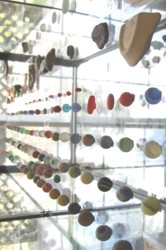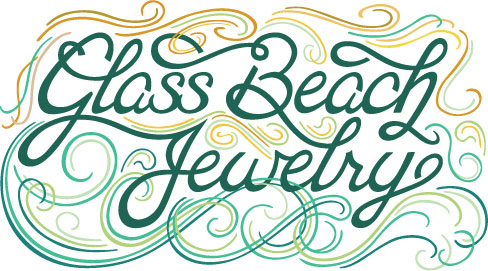Glass Beach Museum

FROM FORT BRAGG, CALIFORNIA'S,
WORLD FAMOUS
"GLASS BEACH"

& MUSEUM
Logo design by Cassie Forrington,
Grahic Artist
www.cforringtondesign.com
THE MOST AFFORDABLE,
GENUINE,
SEA & BEACH GLASS
Jewelry Available!
|
Sea Glass Marble Display Glass Beach Museum  FROM FORT BRAGG, CALIFORNIA'S, WORLD FAMOUS "GLASS BEACH" |
WELCOME TO & MUSEUM Logo design by Cassie Forrington, Grahic Artist www.cforringtondesign.com THE MOST AFFORDABLE, GENUINE, SEA & BEACH GLASS Jewelry Available! |
|
A BRIEF HISTORY OF SEA GLASS (RETURN TO MAIN PAGE) While marketing my sea glass, I have encountered a lot of people who are confused about where sea and beach glass come from. People think there was a ship wrecked here that was full of glass or that there was a glass factory here. Others think sea glass just comes from the sea somehow, a natural wonder. Technically speaking, sea and beach glass are different. Sea glass refers to salt water glass and beach glass refers to fresh water glass. The fine patina of sea and beach glass comes from the glass slowly dissolving in the water. The PH of fresh water is different than salt water so the glass does not dissolve as readily. It still dissolves, and will develop the same patina over time, but it takes much longer in fresh water. In the old days, and I mean the old days, because sea and beach glass has been around as long as we have had glass, it was said to be "Mermaid Tears". It was said that everytime a sailor drowned at sea, the Mermaids would cry and the sea glass was their tears washing up on the shore. And that is the where it comes from....just kidding. Sea and beach glass is found everywhere in the world, because people have discarded glass in the oceans and waterbodies everywhere. It was natural for waterfront communities worldwide to discard their trash in the water because the water carried it away. Landfills were a terrible health hazard in those days, filled with vermin that carried dangerous diseases like the Plague. The world was a much larger place in those days and the population was much smaller. It just made good sense at the time. This practice is still followed in many third world countries. Everywhere Sea Glass is found, and it is found everywhere, its value is partially determined by its color. This is because only a few items were stored in red, blue, lavender, purple or pink glass containers. Likewise certain rare tints and shades of these popular colors are found. For instance, very rare Cobalt Blue, the "sapphire" of the beach, came from such apothacary items as Milk of Magnesia, Vick's Vapo Rub, Noxema, Nivea, and Bromo Seltzer bottles, along with some prescription bottles and perfumes The extremely rare red pieces, or "rubies" of the beach, might come from perfume bottles, the tail lights on old automobiles, lantern and traffic light lenses, or even some types of old beer bottles, like the bottles made by Anchor Hocking for Schlitz Beer in the 1950's. Pinks, lavenders, purples, lime greens and other rare shades came from things like perfume bottles and art glass. Many lavenders and pinks come from what was originally clear glass that was clarified with magnesium (lavender) or selenium (pink). The glass has to be clarified with these minerals because the sand from which glass is made is actually amber in color. Over time the sun causes the magnesium and selenium to oxidize, creating the lavender and pink colors. Greens, browns, and aquas come from beer and soda bottles, and nearly every other source, like Clorox Bleach jugs, shampoos, etc. And sometimes, like in the old town dumps in Fort Bragg, California, the sea glass is also passed through fires and becomes "Fire Glass", the rarest of sea glass, and often has "inclusions" (things inside), just like, or better than, precious gems. In fact, gemological terms like "inclusions", "clarity", "color", "facets" and "purity" also pertain directly to sea glass, except that inclusions and "impurities" are bad in gemstones and often excellent in sea glass, and a lot of people prefer their sea glass "frosted" instead of clear (unless there are "inclusions") and no one would think of buying a cloudy diamond, except to HIDE an inclusion! Sea glass goes back in history for as long as man has had glass. As the raw glass is broken into smaller pieces and slowly polished by the sand as it is rolled around in the surf, it becomes "beach", or "sea" glass: sea glass of gemstone quality. The pits in the surface of the glass, giving it its soft feel, come from a process called "hydration", where the soda and lime used in making the glass is leached out of the glass, leaving the small pits. The soda and lime also often react with minerals in the sea water, forming new mineral deposits on the surface that give the glass a "sparkling" appearance. Most beaches that produce sea glass are open to the sea, so even if the site was originally a town dump, where a lot of material was deposited in one place, like in Fort Bragg until 1967, the glass is drawn off the beach by the sea and distributed up and down the coast by the "longshore currents", making it difficult and rare to find, which explains its normally high cost. Like precious gems, beach glass is rare and beautiful. A lot of sea glass is also found on the beaches in the vicinity of old ship anchorages, like in the Chesapeake Bay, because ships also used to discard their refuse over the side. If you have an old ocean dump site near you, take a stroll on a sunny day and you might find Mermaid Tears glistening in the sun and sand. For those of you interested in Glass Beach in Fort Bragg, there are actually three main sites here. The last was active from 1949 to 1967. This is the area now within the State Park and is what was noted in the August 2007 edition of Martha Stewart's "Living" as being the highest concentration of sea glass in the world. There is actually much more than that here in the middle and first sites. The middle was active from 1943 to 1949. Fort Bragg began ocean dumping in 1906 after the big earthquake that destroyed San Francisco also destroyed the center of town in Fort Bragg. All that refuse was bulldozed into the ocean at the foot of Pine Street and that site was used until 1943. (This is where I kayak to for my sea glass.) Prior to that a lot of people buried their trash in their yards and there might of been a landfill out Simpson Lane because the town was originally out there when the fort was where the town is now, which was about the middle of the Pomo Indian Reservation. The 49-67 and 43-49 sites are both accessible by foot, with a little climbing, and the pre-43 site can only be legally accessed by ocean kayak or boat. I do ocean kayak tours of this site if you are interested. The locals are serious about protecting their magnificent beaches and those who try to come to Fort Bragg to break its laws to trespass into the original site usually leave the beach under police escort and then leave the town on probation. Local collectors who frequent the site legally when posssilbe, and frequent the other sites when they can't, call trespassers in to the police. Do not expect to be be welcome here if you intend to break our laws and steal from our resources. And that, my friend, is a brief history of sea glass. (RETURN TO MAIN PAGE) |
|
Me And "The DaVinci Code", 7/23/2005 A "SEA GLASS" STORY I used to sit down near "Glass Beach", where I collect the Sea Glass, and sell my Sea Glass jewelry to the tourists. I was sitting there one day in June, 2005, reading "The DaVinci Code" to pass my time. I had just read about a five-petaled rose in the book, the major symbol in a book of symbols, because it represents the Holy Grail, which is what the book is about. What I had read was, "The rose is synonymous with the Grail." and was sitting there thinking about that when a woman came back up off the beach and asked me if it was usual to find rose-colored glass. I said, "No, rose is very rare. I don't even have any." She said, "Well, I found a piece," and put her hand in her pocket. I expected her to pull out a small pebble. Instead, she handed me one of the most beautiful pieces of beach glass I have ever seen come off the beach. I looked at it and was totally in awe when I saw it had a perfect five-petaled rose on it, complete with three sets of leaves: the very same rose I was reading about in the book when she walked up! (Picture below) When I showed her what I reading in the book, she gave me the piece of sea glass, the most beautiful piece of beach glass I have seen. God forgive me, I think her name is Celia. The finishing touch was that she was from "Santa Rosa", or "Saint Rose", California. A friend of mine from New Brunswick, Canada, Rachel, found a similar piece with the same pattern and managed to find it online. It was made by Jennifer Glass between 1932 and 1934, and the pattern name is "Adam", which means "man". This is the world of magic and light I live in. Beautiful, often not-so-sublime, synchronicities everyhwere. Please read my "Symbol of Unity" site for how to live in a world like this, too. |
|
An Officer and A Gentleman, Captain Cass Forrington CONTACT INFO: Mail: Capt. J. H. (Cass) Forrington P. O. Box 56 Fort Bragg, Ca 95437 Mendocino County United States of America Lat 39-26.5N Long 123-48.5W Phone: +707-357-1585 Email Me Site Map |